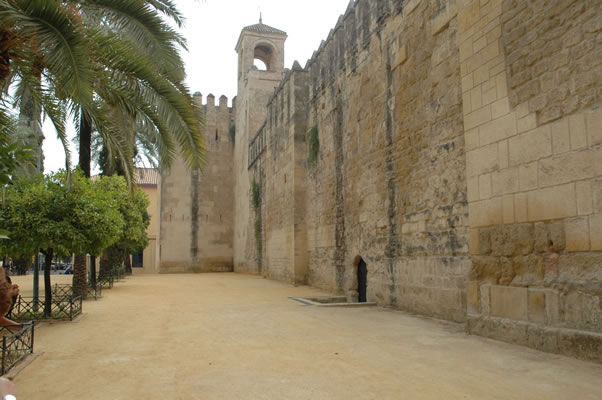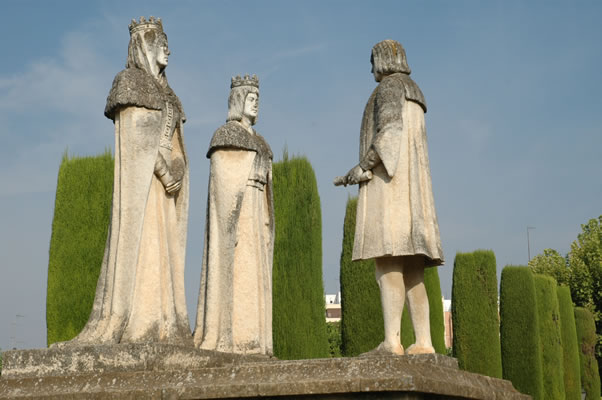Columbus, Queen Isabella and King Ferdinand in Cordoba: The Real Connections
Cordoba Info
Cordoba Hotels
Restaurants
Food
Photos
Map
History
Monuments
Museums
Festivals
Events
News
Weather
Practical Info
Tips for visitors
Spanish courses
Province
About us
Email
Many books state that Queen Isabella and King Ferndinand (Isabel and Fernando, los Reyes Católicos) gave Christopher Columbus his commission while they were residing in Cordoba. The court was officially based in Cordoba then, and Isabella was residing in the Alcazar Castle on the banks of the Guadalquivir River. The monarchs moved around, however, making it easy for modern day tourist authorities and travel writers to mess up their claim stakes along Columbus' path to glory. Nevertheless, Cordoba was undoubtedly an important way point in Columbus' long campaign to gain fame, fortune and aristocratic status by gaining royal backing and establishing a direct trade route with India (a project which failed, but led to the discovery of America). What we can say is that he was attracted to Cordoba by two women: Isabel, Queen of Castile, and Beatriz Enriquez de Harana, a weaver of humble origin.
Of Columbus' first audience in 1485 with the Catholic Monarchs there is no written record. In March, Isabel had moved the court from Seville to Cordoba, where she could better direct the military campaign against the Moorish kingdom of Granada. We know that the preliminary commission designated to check his calculations was not convinced, but Isabel and Ferdinand must have found the project tempting. A new direct trade route with the East might compensate their losses of tribute from the Moors of Granada and their recent exclusion by treaty from West Africa.
By 1487, Christopher Columbus was living in Cordoba, perhaps because of his romantic liaison with Beatriz Enriquez de Harana, the soon-to-be mother of his son Hernando, and perhaps because of a need to be closer to the court. It was in that year, in Cordoba, that he received his first modest grant of 3,000 marevedies to assist with his living expenses and travel. But his was a project on the back burner, and at a slow simmer.
In August 1488, Columbus may have been back in Cordoba for the birth of Hernando. He received an invitation to the court of João II of Portugal and another subsidy from Ferdinand and Isabella, who were holding court in Valencia at the time. Isabella did not want the heavy expense of a doomed expedition, but neither did she want the entrepreneur to take his project to someone else.
Christopher Columbus wins the Spanish monarchs' support
After years of waiting, and with the help of a former official of Isabel and monk from La Rábida monastery, he was able to gain another hearing in 1491 with Isabel's royal commission in Santa Fe, outside the besieged Granada. They considered his project once more, and once more it was rejected. Columbus set out again for Cordoba, from whence he planned to travel north to make an appeal to the king of France.
Luckily for Columbus (and for the Spanish monarchs), the shrewd King Ferdinand intervened, causing a last-minute about-face which sent messengers scrambling after Columbus to bring him back to court. They didn't think Columbus would come back alive from his expedition, but they certainly didn't want to lose out on the benefits if he did. Perhaps their lack of faith in the voyage was why they granted him 10% of the profits, noble status and hereditary governorship of the new territories to him and his descendants if he succeeded.
Columbus pays one last visit to family in Cordoba before his historic voyage
April 17, 1492 Ferdinand and Isabel signed the formal agreement with Columbus, who left Granada in May. On his way to the Huelva coast, where he would outfit his expedition, he passed through Cordoba to see Beatriz and his son Hernando, then 5. No doubt he wondered if it would be the last time he saw them. Three months later, on August 3, his expedition set out from Palos on the Niña, Pinta and Santa Maria and sailed into the unknown.

Sources: Interesting details of Columbus' negotiations and movements in the years prior to 1492 can be found in Phillips.
Academic Citations: How to link to this page
updated 1 Mar 2013
about us | disclaimer ©2005-2014 Tony Reed




